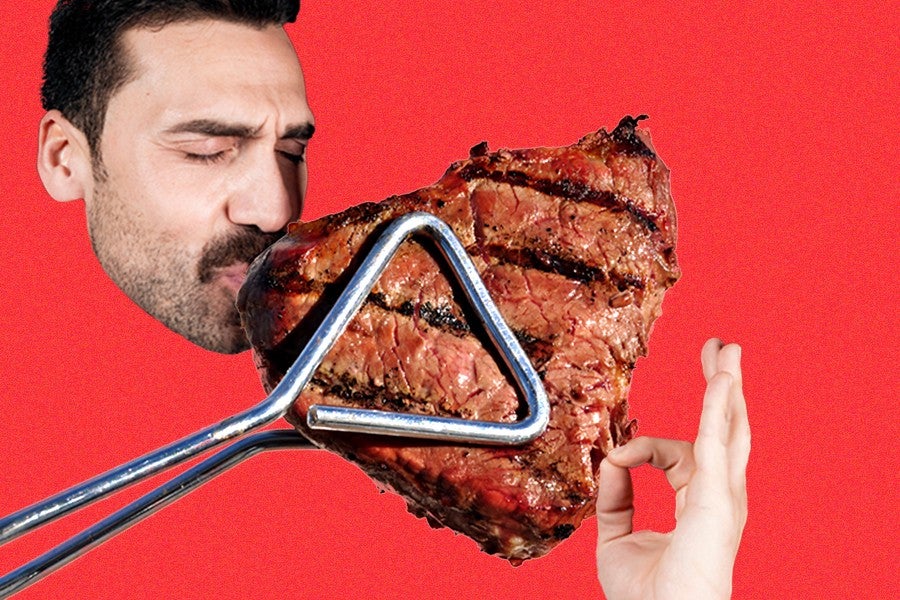Attention, everyone who foolishly called themselves King of the Grill after ruining a Fourth of July barbecue by burning $300 worth of high-grade meat purchased from a specialty butcher: Everything your parents taught you about grilling is wrong.
All right, I’m slipping into didactic men’s mag cliche here. But the fact is, many of us do stick to the grilling lessons we absorb growing up, and many of them are flat-out wrong. Here, I’m taking a look at the most common things we fuck up and how to fix them, with some help from grilling authority Steven Raichlen, author of Project Fire and host of the Project Fire series on PBS.

The Myth: Pricking sausages before grilling prevents them from bursting or splitting.
The Truth: This practice became commonplace during World War II, since — due to rationing — sausages were often filled with bread and water that would expand and explode when heated. In fact, it was this explosive phenomenon that reportedly inspired soldiers to begin referring to sausages as “bangers.”
These days, however, pricking sausages simply allows the flavorful fat to escape while cooking, leaving you with a dry hunk of meat. Therefore, to prevent sausages from splitting, simply cook them slowly over low heat, turning several times while grilling. “What I actually recommend is indirect grilling the sausage, rather than direct grilling it,” Raichlen says. “That way, the casing gets really crisp, the meat cooks, you don’t lose any juices and you don’t have to worry about burning it.”
The Myth: Searing meat seals in moisture.
The Truth: Searing meat actually causes the moisture on its surface to evaporate, leading to a chemical change known as the Maillard Reaction, which produces the quintessential browned color and seared, savory taste of barbecue (and also might cause cancer). At the end of the day, while this reaction does produce a tastier piece of meat when done right, it doesn’t in any way lock in moisture: Meat with a high fat content that’s been cooked to the appropriate internal temperature and then allowed to rest for at least five minutes will be the most moist, regardless of searing.
The Myth: If you’re looking, you ain’t cooking.
The Truth: This myth pushes the notion that opening the lid will significantly slow the cooking process, which simply isn’t true. While doing so can cause the temperature inside of the grill to drop, scientist and barbecue enthusiast Greg Blonder found that this change has virtually no impact on the center of the meat. In other words, the meat will continue to cook regardless of whether or not you’re opening the lid to baste, flip or insert a thermometer.
Still, you shouldn’t go leaving the lid open for long periods of time. “I wouldn’t get overly hysterical about this, but it’s true that it’s better to have your grill closed more often than open,” Raichlen says.
The Myth: Neat grill marks signify perfectly-cooked meat.
The Truth: Meathead Goldwyn, author of Meathead, The Science of Great Barbecue and Grilling and self-proclaimed barbecue whisperer, previously told us that grill marks are overrated: “Those beautiful grill marks are merely superficial branding, just coloring on the surface. Like the freckles on Lindsay Lohan, they’re cute, but lacking substance.”
According to Goldwyn, the real signifier of well-cooked meat is a solid brown crust formed by the Maillard Reaction, which is why many steakhouses use broilers instead of grills. Per Goldwyn: “The flames are above the meat, that way they can get brown all over. That’s why grill marks don’t make me salivate — I want brown all over.”
The Myth: Chicken is ready when the juices run clear.
The Truth: Here’s a quick science lesson: Meat is pink due to a protein called myoglobin, which no longer appears pink when it’s cooked. However, this color change doesn’t necessarily happen at a fixed temperature, since many other factors come into play, especially the acidity of the meat. Basically, it’s possible for the color of the juices to remain pink after the meat has been thoroughly cooked. Likewise, the color of the juices may run clear before the meat is safe to eat.
That said, Raichlen believes that cooking chicken until the juices run clear is generally a good practice. But if you want to be completely safe, you’re probably better off using a meat thermometer to check whether or not your chicken is done.
The Myth: You shouldn’t flip meat more than once.
The Truth: WRONG. As it turns out, flipping often can actually produce more flavor in less cooking time — at least, according to an experiment performed by American chef and food writer James Kenji López-Alt. In the experiment, López-Alt cooked one dozen half-pound burgers, flipping them at various intervals. The single-flip burgers became darker on the outside, but they were overcooked on the inside. Meanwhile, those that were flipped more often cooked in two-thirds of the time, the edges were more brown and the color was more even top to bottom. Flipping every minute or so seems to provide the best crust and the least overcooked meat beneath the surface.
The Myth: Marinades tenderize meat.
The Truth: This is a controversial subject, according to Raichlen. “One side of the argument says that marinades don’t penetrate deep enough to tenderize the meat,” he explains. “But if you’ve been to Turkey, India or the Middle East, and you’ve had meat that’s marinated for 24 hours in yogurt, it does tenderize the meat. I would say the primary function of a marinade is to add flavor, depending on the marinade. That said, if your marinade has a lot of acid in it — lime juice or yogurt — you will get a tenderizing effect.”

